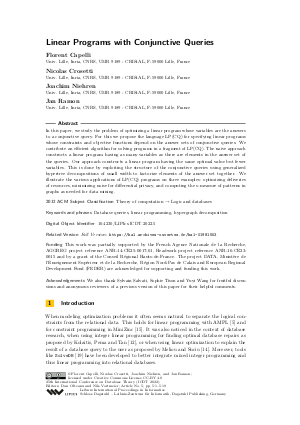@InProceedings{capelli_et_al:LIPIcs.ICDT.2022.5,
author = {Capelli, Florent and Crosetti, Nicolas and Niehren, Joachim and Ramon, Jan},
title = {{Linear Programs with Conjunctive Queries}},
booktitle = {25th International Conference on Database Theory (ICDT 2022)},
pages = {5:1--5:19},
series = {Leibniz International Proceedings in Informatics (LIPIcs)},
ISBN = {978-3-95977-223-5},
ISSN = {1868-8969},
year = {2022},
volume = {220},
editor = {Olteanu, Dan and Vortmeier, Nils},
publisher = {Schloss Dagstuhl -- Leibniz-Zentrum f{\"u}r Informatik},
address = {Dagstuhl, Germany},
URL = {https://drops.dagstuhl.de/entities/document/10.4230/LIPIcs.ICDT.2022.5},
URN = {urn:nbn:de:0030-drops-158796},
doi = {10.4230/LIPIcs.ICDT.2022.5},
annote = {Keywords: Database queries, linear programming, hypergraph decomposition}
}

 Creative Commons Attribution 4.0 International license
Creative Commons Attribution 4.0 International license
















